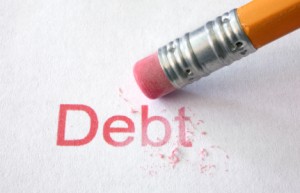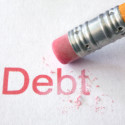 Would you rather just listen? Click here:
Would you rather just listen? Click here:
Dateline: Miami, FL, 2001
“I have good credit. I can just put it on my cards …” I said.
That’s how I justified the poor behavior of my six foreign business partners. They refused to help make up for their government’s decision to hold back the funding it promised our venture.
Somehow I thought it was okay for me to shoulder my part … and theirs … although I was a minority partner.
And then an event occurred that was outside my control – and which I could never have foreseen. By the way, things like that do occur, no matter how well you plan. It’s called “Life.”
In my case it was 9/11. The economy stagnated as the world (and American business in particular) sat waiting for the other shoe to drop. Meanwhile, two of our major clients went bankrupt, ensuring that we wouldn’t ever get paid the second half of the huge year-end orders they had placed.
It was all over. All my cards, business and personal, were maxed out. The business credit line was tapped. No reserves for a hole that large in the budget. No savings. No Plan B.
So I know all about the dark days of debt, seeing the steady stream of bills flowing in and knowing that there’s not that much in all the checking accounts combined.
x-x-x-x-x
I tell you this tale of woe because it’s representative of what often happens when you carry debt … regardless what the details are of your specific story.
However, with changing times, how we look at debt is no longer how we were raised to look at it. And that change has caught many people off guard.
We were told all along that there was “good debt” and “bad debt.” Good debt was seen as an investment: say in a house that would increase in value over time; maybe in an expensive education that would increase one’s lifetime earning capacity.
And “bad debt” was seen as anything incurred for things that devalued with time, such as consumer products, meals, and so forth. This form of debt was (and still is) best represented by what’s carried on our credit cards.
What’s changed today? Well, in keeping with the phrase “the good, the bad and the ugly,” almost all debt today qualifies as ugly. (At least for those of us too unconnected to have access to the inner sanctums of Wall Street firms, mega-billionaire and market manipulator George Soros and others with insider knowledge.)
So what happened to “good debt?” Well, the housing market is giving ample witness to the fact that it is no longer a safe and ever-increasing store of value. Just ask the millions whose mortgages are upside down just in the U.S. – that is, they owe more than the house is worth.
Or ask the unemployed 21-year-olds holding a sheepskin diploma – whether from mid-tier schools or diploma mills – what they think their costly educations are worth now. Granted, unemployment for those holding college degrees is lower than for most others, but a degree is no longer the guarantee of employment it once was.
Pretty ugly.
And what about “bad debt?” Americans are taking on more and more, with a national average interest rate of 14.99% while the cost of money is down under 1%. The huge spread results from a combination of high default rates and getting away with whatever the market can bear.
Still ugly.
And what else has shifted? Frankly, all the foundational economic rules. When trying to forecast how the economy will react to a particular event, there used to be logical rules. But now, it’s hard to advise someone how fast to pay down their outstanding debt, for example. Do they pay down cards or hold on to cash? Since the economic tsunami in 2008, all the government intervention in the markets – bailing out banks and corporations, printing money madly and cutting behind-closed-doors deals – means that A plus B does not equal C any more.
How long will it take for the economy to turn around? We don’t know. Will all the money printing result in hyperinflation? We don’t know. Will government continue covering all the “safety net” entitlements? We don’t know.
So what to do?
Find where your outflow of money equals your inflow of money. If need be, pay down debt to that point. Or increase your income. That balance is where you’ll find your personal point of peace of mind.
If you haven’t started scrambling yet, and you’re carrying debt, it’s time to scramble. (And, radical as it sounds, target having a No-New-Debt holiday season.)
With the level of uncertainty the economy is demonstrating, it’s time to be financially conservative. Do what you can to build up resources that will carry you through unexpected events. Do extra odd jobs to bring in more money if needed to drive down debt or to set money aside.
Am I a total pessimist? No, I’m not. I’m not predicting a dire future because I trust that someone somewhere somehow will put on the brakes before we reach pandemonium.
But I do think we should prepare so we’re functioning from a place of peace of mind, where our judgment is sound, not panicked. That place of peace that will allow us to benefit from any and all opportunities that cross our paths, and give us choices.
A person strapped with debt … or with a home facing foreclosure … or with a declining or at-risk income has few choices.
Don’t let that be you!
Drop me a note down below, in the comment section, and let me know if you think you’re doing everything you can to reach “peace of mind.”
xxxxxxxxxx
 Bio: Sharon O’Day lost everything at age 53: her home, her business, everything. But how could that be? She’s an expert in global finance and marketing with an MBA from the Wharton School. She has worked with governments, corporations, and individuals … yes, she was the secret “weapon,” if you will, behind many individuals in high places. Yet she did! Since then, with her finances completely turned around, Sharon has gone on to interview countless women. She’s done extensive research to understand how that could have happened, especially with her strong knowledge of numbers and finance.
Bio: Sharon O’Day lost everything at age 53: her home, her business, everything. But how could that be? She’s an expert in global finance and marketing with an MBA from the Wharton School. She has worked with governments, corporations, and individuals … yes, she was the secret “weapon,” if you will, behind many individuals in high places. Yet she did! Since then, with her finances completely turned around, Sharon has gone on to interview countless women. She’s done extensive research to understand how that could have happened, especially with her strong knowledge of numbers and finance.
The surprising answers will be shared in her upcoming book “Money After Menopause.” Today her mission is to show as many women as possible how to become financially free for the long term, through her “Over Fifty and Financially Free” coaching programs. She has developed a step-by-step plan to get past all the obstacles that keep women broke and scared … and from reaching the financial peace of mind they so deserve.






